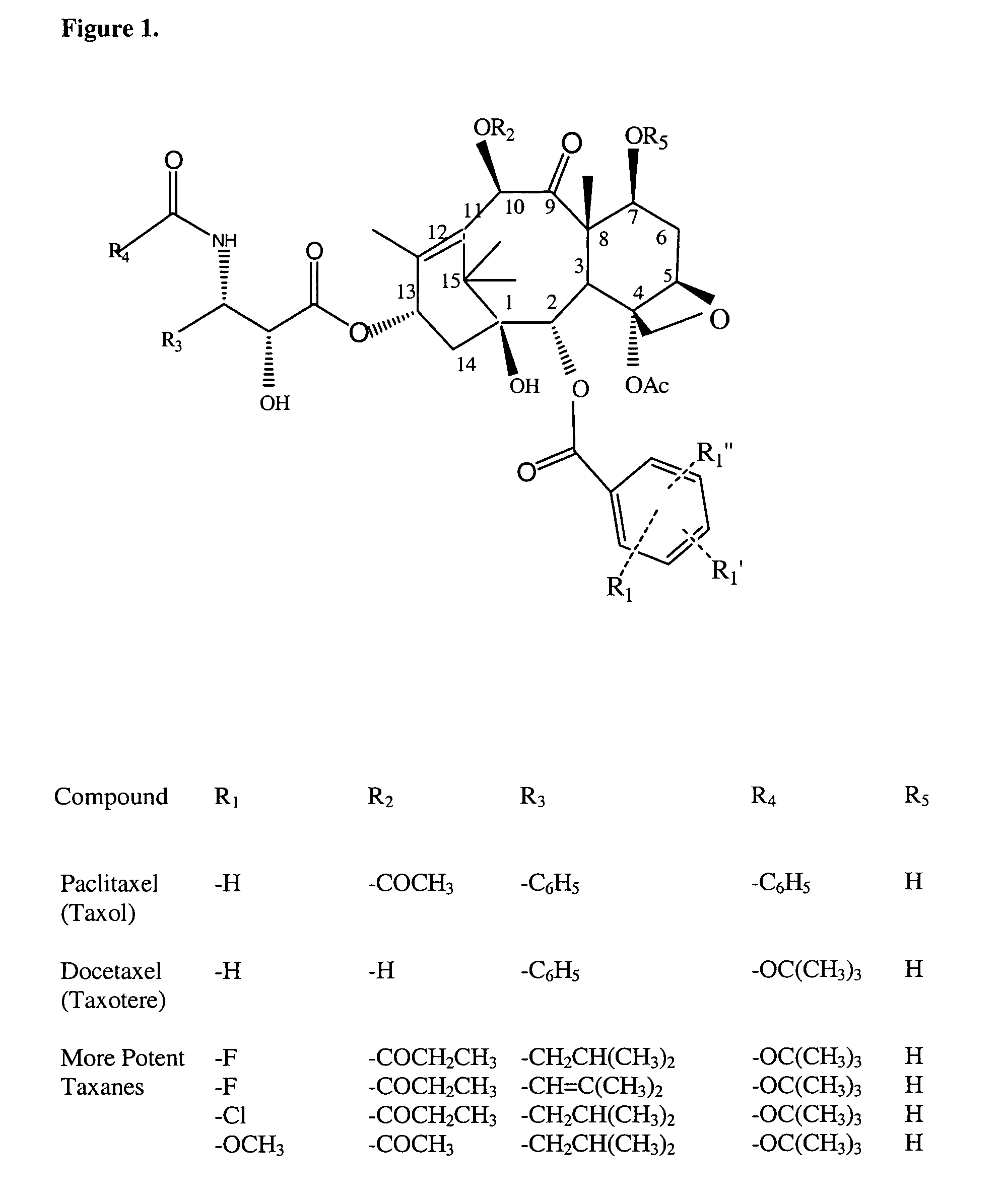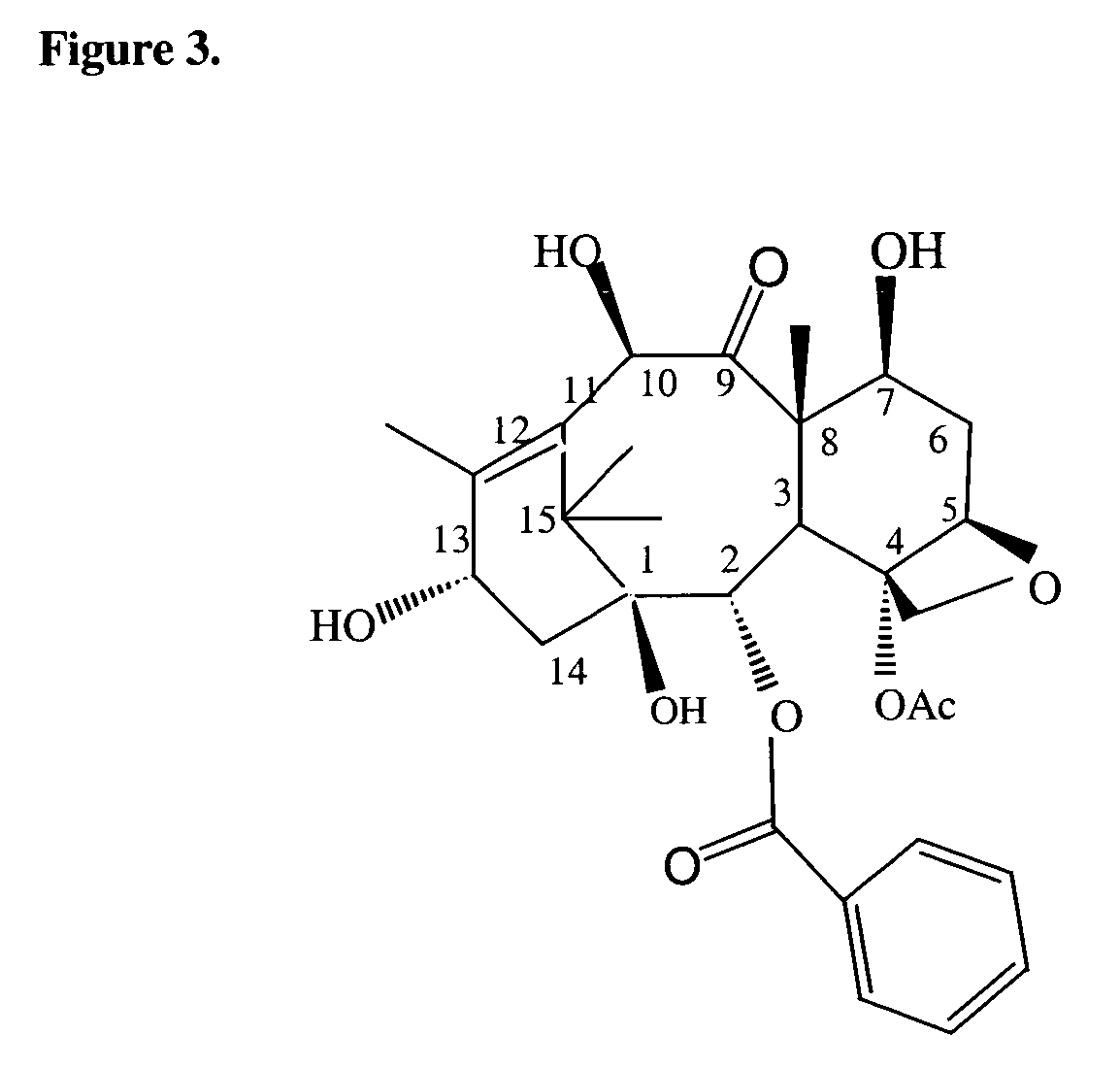Cytotoxic agents comprising taxanes and their therapeutic use
a cytotoxic agent and taxanoid technology, applied in the direction of immunoglobulins, peptides, drugs against animals/humans, etc., can solve the problems of ineffective mechanism by which drug molecules are released from antibodies, difficult chemical modification of existing drugs, and difficult to diminish the cytotoxic potential of existing drugs, etc., to achieve the effect of effective us
- Summary
- Abstract
- Description
- Claims
- Application Information
AI Technical Summary
Benefits of technology
Problems solved by technology
Method used
Image
Examples
example 1
In Vitro Cytotoxicity Assays
[0103]The sulfide, disulfide, and sulfhydryl containing taxane drugs of the invention can be evaluated for their ability to suppress proliferation of various human tumor cell lines in vitro. Two adherent cell lines A431(human epidermoid carcinoma) and SKBR3 (human breast tumor) and the non-adherent cell line, Narnalwa (Burkitt's lymphoma) are used for the assessment of cytotoxicity of these compounds. Cells are exposed to the compounds for 24 hours and the surviving fractions of cells are measured in direct assays. (A431 and SKBR3 are assayed for plating efficiency (Goldmacher et al, 102 J. Cell. Biol. 1312–1319 (1986) and Namalwa are assayed by growth back extrapolation (Goldmacher et al, 135 J. Immunol. 3648–3651 (1985)). IC50 values are then calculated from this data.
example 2
Conjugation to Antibodies
[0104]Conjugation of Thiol-containing Taxane to Antibodies via Disulfide Links: The conjugation of thiol-containing taxanes to antibodies, or fragments thereof, via disulfide links is performed in two steps. In the first step dithiopyridyl groups are introduced into antibodies or antibody fragments using succinimidyl pyridyl-dithiopentanoate (SPP) as described by Carlsson et al. The thiopyridyl groups are then displaced by reaction with the thiol-containing taxane to produce a conjugate.
[0105]Preparation of Antibody-SS-Taxane Conjugates. Antibodies anti-B4, anti-EGF receptor and N901, or fragments thereof, are modified with SPDP or SPP as described in the literature. Between 1 to 10 dithiopyridyl groups are introduced on the average per antibody molecule.
[0106]A solution of the dithiopyridyl modified antibody at a concentration of 1 mg / ml in 0.1 M potassium phosphate buffer pH 6.5 containing 1 mM EDTA at 25° C. is treated with a thiol-containing taxane (1.25...
example 3
Preparation of Anti-EGFR Antibody KS-61-Taxane Conjugate
[0111]The anti-EGFR antibody KS-61 was first modified with N-succinimidyl-4-[2-pyridyldithio] pentanoate (SPP) to introduce dithiopyridyl groups. The antibody (2.3 mg / mL) in 50 mM potassium phosphate buffer, pH 6.5, containing NaCl (50 mM) and EDTA (2 mM), was treated with SPP (11 molar equivalents in ethanol). The final ethanol concentration was 1.4% (v / v). After 90 minutes at ambient temperature, lysine (50 mM) was added to help in the removal of any non-covalently bound SPP. The reaction was allowed to proceed for two hours, and then purified by gel filtration through a Sephadex G25 column equilibrated in the above buffer. Antibody-containing fractions were pooled and the degree of modification was determined by treating a sample with dithiothreitol and measuring the change in absorbance at 343 nm (release of pyridine-2-thione with ε343=8,080 M−1 cm−1). Recovery of the antibody was about 90%, with 5.0 pyridyldithio groups li...
PUM
| Property | Measurement | Unit |
|---|---|---|
| pH | aaaaa | aaaaa |
| concentration | aaaaa | aaaaa |
| concentration | aaaaa | aaaaa |
Abstract
Description
Claims
Application Information
 Login to View More
Login to View More - R&D
- Intellectual Property
- Life Sciences
- Materials
- Tech Scout
- Unparalleled Data Quality
- Higher Quality Content
- 60% Fewer Hallucinations
Browse by: Latest US Patents, China's latest patents, Technical Efficacy Thesaurus, Application Domain, Technology Topic, Popular Technical Reports.
© 2025 PatSnap. All rights reserved.Legal|Privacy policy|Modern Slavery Act Transparency Statement|Sitemap|About US| Contact US: help@patsnap.com



